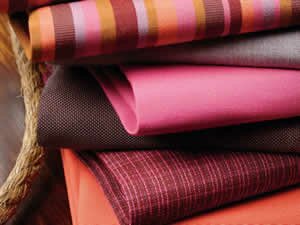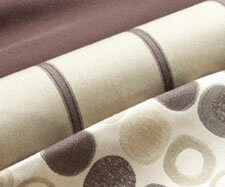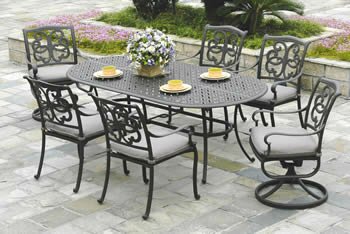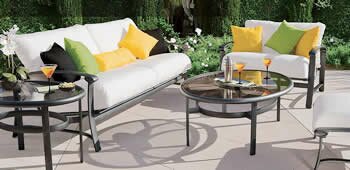 Many styles of outdoor furniture are made to be used with fabric covered outdoor cushions. However, as outdoor cushions and fabrics are considered to be “soft goods,” they are not quite as bullet proof against Mother Nature as the harder materials from which the furniture is constructed. But don’t despair! You can use cushioned furniture outside even in uncovered areas without being a slave to the cushions.
Many styles of outdoor furniture are made to be used with fabric covered outdoor cushions. However, as outdoor cushions and fabrics are considered to be “soft goods,” they are not quite as bullet proof against Mother Nature as the harder materials from which the furniture is constructed. But don’t despair! You can use cushioned furniture outside even in uncovered areas without being a slave to the cushions.
Because outdoor cushions are just that—made for outdoor use, you can safely assume that these items will be able to handle moisture and sun. You just need to do your homework in order to evaluate the ability of the cushions to satisfy your needs. The main factors to take into consideration are the core material, cushion fabric, and fabric coloring process.
Outdoor cushions may be constructed of various types of core materials including foam, foam and a polywrap, or polyfill. Each construction method provides a different look, feel and, perhaps most importantly, “sit” to the furniture.
Foam is denser and more rigid than the other type of cushion fill, polyfill. Generally, foam will retain its shape and thickness longer than others but it will also retain moisture longer. One way to lessen drying time is to select an outdoor furniture style that has a thinner foam cushion. Foam cushions tend to look boxy and rigid but by adding a wrap of poly around the core, the cushion takes on a softer shape and a more comfortable feel.
Polyfill is not as dense or as heavy as foam and has a softer look and “sit.” The look of a polyfill cushion is softer and usually more rounded looking than a foam cushion. Without the foam core, a cushion constructed of polyfill will generally dry faster than one of foam.
New advancements are continually being made in the area of outdoor cushions. Manufacturers who are committed to producing top quality furniture have begun using a better quality cushion core system that includes a moisture barrier. Placed between the cushion core and the outer fabric, this barrier is a tightly woven fabric that acts like a diaper in reverse, keeping most moisture from penetrating into the cushion core. When paired with a 100% solution dyed acrylic fabric, this cushion construction will provide the best long term results when used in an exposed area. Even thick, plush outdoor cushions can be used in uncovered areas with little down time due to moisture with this desirable cushion construction.
 A growing interest in the outdoor living lifestyle has increased the selection of outdoor fabrics available today. Prints, wovens, solids, and patterns of all types are available for use outside.
A growing interest in the outdoor living lifestyle has increased the selection of outdoor fabrics available today. Prints, wovens, solids, and patterns of all types are available for use outside.
The fibers used in outdoor fabric construction are man-made. Natural fibers such as cotton, linen, silk or wool will not hold up outside. They will fade and mildew quickly as well as succumb to dry rot with prolonged exposure to the sun (direct or indirect). Man-made fibers such as acrylic, olefin and polyester are the fibers used in making outdoor fabric. Acrylic is the most desirable and expensive of the outdoor fabrics. A solution-dyed acrylic fabric is the most desirable of all.
Outdoor fabrics may be printed or solution-dyed. Printing is a process where the color and pattern (if there is one) is applied on top of the base fabric. In order to make the color sustain more hours in the sun before fading (which printed fabrics will ultimately do), the manufacturer adds ultraviolet stabilizers into the dye. In general, these fabrics will look better longer if used in a covered area.
 A solution-dyed acrylic fabric is the most desirable of all. In the solution dying process, yarns are dyed before the fabric is woven. The color is locked in, so to speak. Originally designed for the marine industry, solution dyed fabrics are the best choice for cushions to be exposed to strong sun. Outdoor fabrics that are solution dyed will retain their color the longest and may be left in the sun and rain all season. Solution dyed fabrics are also virtually colorfast and may be bleached. Sunbrella and Outdura are well known solution dyed fabrics that resist fading, staining and mildew. They are both top choices for serviceability and long life.
A solution-dyed acrylic fabric is the most desirable of all. In the solution dying process, yarns are dyed before the fabric is woven. The color is locked in, so to speak. Originally designed for the marine industry, solution dyed fabrics are the best choice for cushions to be exposed to strong sun. Outdoor fabrics that are solution dyed will retain their color the longest and may be left in the sun and rain all season. Solution dyed fabrics are also virtually colorfast and may be bleached. Sunbrella and Outdura are well known solution dyed fabrics that resist fading, staining and mildew. They are both top choices for serviceability and long life.
 To understand the difference between printed and solution-dyed fabrics, think of a carrot vs. a radish. A carrot is the same color throughout. This is like a solution-dyed fabric.
To understand the difference between printed and solution-dyed fabrics, think of a carrot vs. a radish. A carrot is the same color throughout. This is like a solution-dyed fabric.
A radish, on the other hand, is red on the outside but, once peeled, it is white on the inside. This is a printed or vat-dyed fabric. Once the sun has faded the topical color of these fabrics, the base cloth color (white) will begin to come through.
 It is important to know what type of fabric you have and how it is dyed when approaching the task of cleaning cushions. Bleach may not be used on non- solution dyed, printed fabrics. Warm soapy water mixed with a mild detergent is recommended to clean all non-solution dyed fabrics. A soft bristled brush may usually be used in the cleaning process to help remove stubborn dirt.
It is important to know what type of fabric you have and how it is dyed when approaching the task of cleaning cushions. Bleach may not be used on non- solution dyed, printed fabrics. Warm soapy water mixed with a mild detergent is recommended to clean all non-solution dyed fabrics. A soft bristled brush may usually be used in the cleaning process to help remove stubborn dirt.
A solution dyed fabric may be cleaned with a mild soap and water and bleach. The recommended mix is ¼ cup of bleach with 2 capfuls of soap per 1 gallon of cold water. Whenever using bleach, rinse well. Lingering bleach residue can be irritating and may interact with the sun and cause damage to both fabric and threads in the future.
Some outdoor fabric products may be washed in a machine with cold water only. Remember to zip the cover closed when washing in a machine so that threads do not get caught in the zipper. Do not use hot water or put outdoor fabrics in the dryer! Place the wet fabric, cushions or pillows in the sun and allow to air dry. Once the cushion covers are dry, put the covers back on the cushion cores.
 So, how to handle wet outdoor cushions that are caught in a storm, a sprinkler that has missed its mark or the high humidity in certain regions?
So, how to handle wet outdoor cushions that are caught in a storm, a sprinkler that has missed its mark or the high humidity in certain regions?
Surprisingly enough, the sun is generally your friend when it comes to maintaining outdoor cushions. The sun helps keep cushions dry and thus protects from mildew. Mildew is a living organism that feeds on dirt and grows in dark, damp places. Providing these conditions will allow mildew to live. Thus, storing (in a dark place) a moist cushion (or other “soft goods”) is an invitation for mildew to come on in. Letting them dry out in the sun before storing or covering is advised.
Many outdoor materials contain mildew inhibitors which will help control mildew growth. However, nothing is 100% safe from mildew.
 Protective covers should be purchased if you want to minimize cleaning as well as wear and tear over the years. The use of protective covers will help keep your outdoor cushions dry when not in use. In addition, covers will reduce cleaning as they help keep dirt, leaves and animals from soiling the cushion. Before putting any protective covers away (or cushions, pillows, fabric, umbrellas, etc.) you must make sure that they are dry or you will find that mildew has found a home.
Protective covers should be purchased if you want to minimize cleaning as well as wear and tear over the years. The use of protective covers will help keep your outdoor cushions dry when not in use. In addition, covers will reduce cleaning as they help keep dirt, leaves and animals from soiling the cushion. Before putting any protective covers away (or cushions, pillows, fabric, umbrellas, etc.) you must make sure that they are dry or you will find that mildew has found a home.
Have questions on the essentials of outdoor furniture and accessories? Just ask we'd be glad to help.
 Many styles of outdoor furniture are made to be used with fabric covered outdoor cushions. However, as outdoor cushions and fabrics are considered to be “soft goods,” they are not quite as bullet proof against Mother Nature as the harder materials from which the furniture is constructed. But don’t despair! You can use cushioned furniture outside even in uncovered areas without being a slave to the cushions.
Many styles of outdoor furniture are made to be used with fabric covered outdoor cushions. However, as outdoor cushions and fabrics are considered to be “soft goods,” they are not quite as bullet proof against Mother Nature as the harder materials from which the furniture is constructed. But don’t despair! You can use cushioned furniture outside even in uncovered areas without being a slave to the cushions. Foam
Foam Cushion Core System
Cushion Core System Caring for Cushions
Caring for Cushions Protective covers should be purchased if you want to minimize cleaning as well as wear and tear over the years. The use of protective covers will help keep your outdoor cushions dry when not in use. In addition, covers will reduce cleaning as they help keep dirt, leaves and animals from soiling the cushion. Before putting any protective covers away (or cushions, pillows, fabric, umbrellas, etc.) you must make sure that they are dry or you will find that mildew has found a home.
Protective covers should be purchased if you want to minimize cleaning as well as wear and tear over the years. The use of protective covers will help keep your outdoor cushions dry when not in use. In addition, covers will reduce cleaning as they help keep dirt, leaves and animals from soiling the cushion. Before putting any protective covers away (or cushions, pillows, fabric, umbrellas, etc.) you must make sure that they are dry or you will find that mildew has found a home.




 A growing interest in the outdoor living lifestyle has increased the selection of outdoor fabrics available today. Prints, wovens, solids, and patterns of all types are available for use outside.
A growing interest in the outdoor living lifestyle has increased the selection of outdoor fabrics available today. Prints, wovens, solids, and patterns of all types are available for use outside. A solution-dyed acrylic fabric is the most desirable of all. In the solution dying process, yarns are dyed before the fabric is woven. The color is locked in, so to speak. Originally designed for the marine industry, solution dyed fabrics are the best choice for cushions to be exposed to strong sun. Outdoor fabrics that are solution dyed will retain their color the longest and may be left in the sun and rain all season. Solution dyed fabrics are also virtually colorfast and may be bleached. Sunbrella and Outdura are well known solution dyed fabrics that resist fading, staining and mildew. They are both top choices for serviceability and long life.
A solution-dyed acrylic fabric is the most desirable of all. In the solution dying process, yarns are dyed before the fabric is woven. The color is locked in, so to speak. Originally designed for the marine industry, solution dyed fabrics are the best choice for cushions to be exposed to strong sun. Outdoor fabrics that are solution dyed will retain their color the longest and may be left in the sun and rain all season. Solution dyed fabrics are also virtually colorfast and may be bleached. Sunbrella and Outdura are well known solution dyed fabrics that resist fading, staining and mildew. They are both top choices for serviceability and long life. To understand the difference between printed and solution-dyed fabrics, think of a carrot vs. a radish. A carrot is the same color throughout. This is like a solution-dyed fabric.
To understand the difference between printed and solution-dyed fabrics, think of a carrot vs. a radish. A carrot is the same color throughout. This is like a solution-dyed fabric.  It is important to know what type of fabric you have and how it is dyed when approaching the task of cleaning cushions. Bleach may not be used on non- solution dyed, printed fabrics. Warm soapy water mixed with a mild detergent is recommended to clean all non-solution dyed fabrics. A soft bristled brush may usually be used in the cleaning process to help remove stubborn dirt.
It is important to know what type of fabric you have and how it is dyed when approaching the task of cleaning cushions. Bleach may not be used on non- solution dyed, printed fabrics. Warm soapy water mixed with a mild detergent is recommended to clean all non-solution dyed fabrics. A soft bristled brush may usually be used in the cleaning process to help remove stubborn dirt. So, how to handle wet outdoor cushions that are caught in a storm, a sprinkler that has missed its mark or the high humidity in certain regions?
So, how to handle wet outdoor cushions that are caught in a storm, a sprinkler that has missed its mark or the high humidity in certain regions?